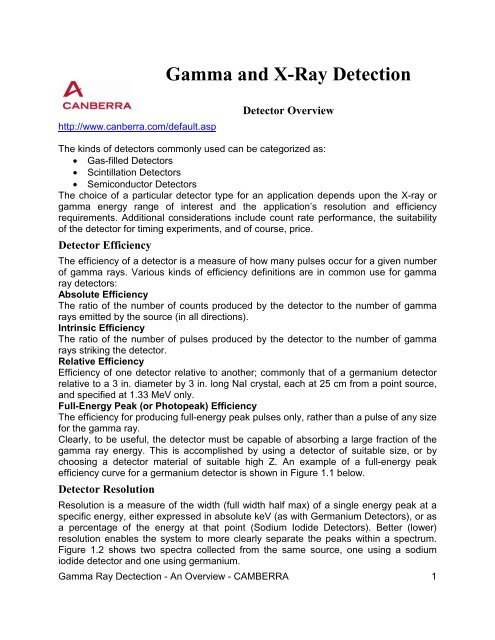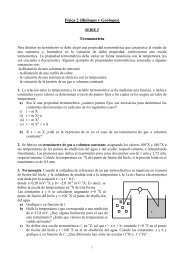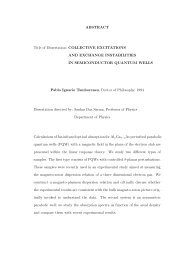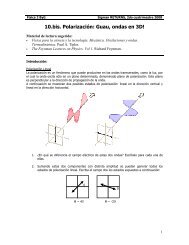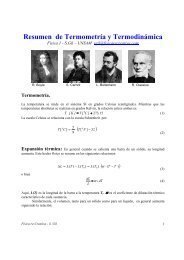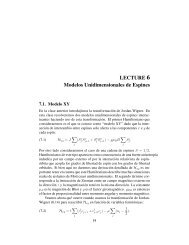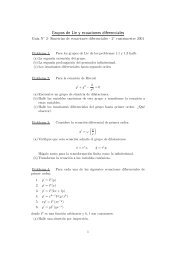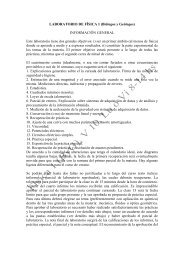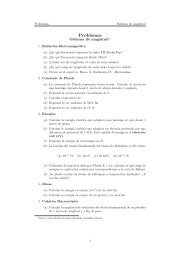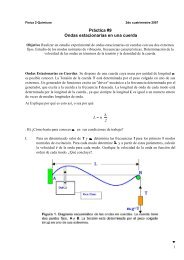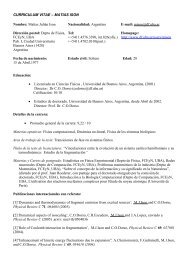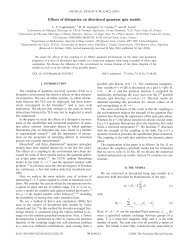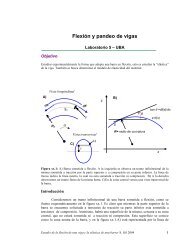Gamma and X-Ray Detection
Gamma and X-Ray Detection
Gamma and X-Ray Detection
You also want an ePaper? Increase the reach of your titles
YUMPU automatically turns print PDFs into web optimized ePapers that Google loves.
Figure 1.1 Efficiency CalibrationEven though this is a rather simple spectrum, the peaks presented by the sodium iodidedetector are overlapping to some degree, while those from the germanium detector areclearly separated. In a complex spectrum, with peaks numbering in the hundreds, theuse of a Germanium detector becomes m<strong>and</strong>atory for analysisFigure 1.2 shows two spectra collected from the same source, one using a sodiumiodide detector <strong>and</strong> one using germanium.Gas-Filled DetectorsA gas-filled detector is basically a metal chamber filled with gas <strong>and</strong> containing apositively biased anode wire. A photon passing through the gas produces free electrons<strong>Gamma</strong> <strong>Ray</strong> Dectection - An Overview - CAMBERRA 2
The family of curves are derived from NBS circular 583 (1956), Table 37, mass attenuation coefficients forNaI(Tl). Each curve represents the percent absorption (l-attenuation) of a parallel beam of gamma raysnormally incident on that thickness NaI(Tl) crystal.Compiled from NBS Circular 583 <strong>and</strong> supplement to NBS Circular 583. (Estimated Max. Error ±2%)Many configurations of NaI detectors are commercially available, ranging from crystalsfor x-ray measurements in which the detector is relatively thin (to optimize resolution atthe expense of efficiency at higher energies), to large crystals with multiple phototubes.Crystals built with a well to allow nearly spherical 4p geometry counting of weaksamples are also a widely-used configuration. A typical preamplifier <strong>and</strong> amplifiercombination is shown in Figure 1.7.Figure 1.7: NaI(Tl) Detector ElectronicsThe light decay time constant in NaI is about 0.25 microseconds, <strong>and</strong> typical chargesensitive preamplifiers translate this into an output pulse rise time of about 0.5microseconds. For this reason, NaI detectors are not as well-suited as plastic detectorsfor fast coincidence measurements, where very short resolving times are required.Plastic ScintillatorsMany types of plastic scintillators are commercially available <strong>and</strong> find applications in fasttiming, charged particle or neutron detection, as well as in cases where the rugged<strong>Gamma</strong> <strong>Ray</strong> Dectection - An Overview - CAMBERRA 4
nature of the plastic (compared to NaI), or very large detector sizes, are appropriate.Subnanosecond rise times are achieved with plastic detectors coupled to fastphotomultiplier tubes, <strong>and</strong> these assemblies are ideal for fast timing work.Separate outputs are usually used for timing, with the positive dynode output to apreamplifier <strong>and</strong> amplifier for energy analysis, <strong>and</strong> the larger negative anode output to afast discriminator, as shown in Figure 1.8.Semiconductor DetectorsFigure 1.8: Plastic Scintillation Detector ElectronicsA semiconductor is a material that can act as an insulator or as a conductor. Inelectronics the term "solid state" is often used interchangeably with semiconductor, butin the detector field the term can obviously be applied to solid scintillators. Therefore,semiconductor is the preferred term for those detectors which are fabricated from eitherelemental or compound single crystal materials having a b<strong>and</strong> gap in the range ofapproximately 1 to 5 eV. The group IV elements Silicon <strong>and</strong> Germanium are by far themost widely-used semiconductors, although some compound semiconductor materialsare finding use in special applications as development work on them continues.Table 1.1 shows some of the key characteristics of various semiconductors as detectormaterials:Material ZB<strong>and</strong>Gap(eV)Si 14 1.12 3.61Ge 32 0.74 2.9848-CdTe521.47 4.4380-Hgl2532.13 6.531-GaAs331.43 5.2Energy/e-hpair (eV)Table 1.1: Element vs. B<strong>and</strong> GapSemiconductor detectors have a P-I-N diode structure in which the intrinsic (I) region iscreated by depletion of charge carriers when a reverse bias is applied across the diode.When photons interact within the depletion region, charge carriers (holes <strong>and</strong> electrons)are freed <strong>and</strong> are swept to their respective collecting electrode by the electric field. The<strong>Gamma</strong> <strong>Ray</strong> Dectection - An Overview - CAMBERRA 5
esultant charge is integrated by a charge sensitive preamplifier <strong>and</strong> converted to avoltage pulse with an amplitude proportional to the original photon energy.Since the depletion depth is inversely proportional to net electrical impurityconcentration, <strong>and</strong> since counting efficiency is also dependent on the purity of thematerial, large volumes of very pure material are needed to ensure high countingefficiency for high energy photons.Prior to the mid-1970’s the required purity levels of Si <strong>and</strong> Ge could be achieved only bycounter-doping P-type crystals with the N-type impurity, lithium, in a process known aslithium-ion drifting. Although this process is still widely used in the production of Si(Li) X-ray detectors, it is no longer required for germanium detectors since sufficiently purecrystals have been available since 1976.The b<strong>and</strong> gap figures in Table 1.1 signify the temperature sensitivity of the materials<strong>and</strong> the practical ways in which these materials can be used as detectors. Just as Getransistors have much lower maximum operating temperatures than Si devices, so doGe detectors. As a practical matter both Ge <strong>and</strong> Si photon detectors must be cooled inorder to reduce the thermal charge carrier generation (noise) to an acceptable level.This requirement is quite aside from the lithium precipitation problem which made theold Ge(Li), <strong>and</strong> to some degree Si(Li) detectors, perishable at room temperature.The most common medium for detector cooling is liquid nitrogen, however, recentadvances in electrical cooling systems have made electrically refrigerated cryostats aviable alternative for many detector applications.In liquid nitrogen (LN 2 ) cooled detectors, the detector element (<strong>and</strong> in some casespreamplifier components), are housed in a clean vacuum chamber which is attached toor inserted in a LN 2 Dewar. The detector is in thermal contact with the liquid nitrogenwhich cools it to around 77 °K or –200 °C. At these temperatures, reverse leakagecurrents are in the range of 10 -9 to 10 -12 amperes.In electrically refrigerated detectors, both closed-cycle Freon <strong>and</strong> helium refrigerationsystems have been developed to eliminate the need for liquid nitrogen. Besides theobvious advantage of being able to operate where liquid nitrogen is unavailable orsupply is uncertain, refrigerated detectors are ideal for applications requiring long-termunattended operation, or applications such as undersea operation, where it isimpractical to vent LN 2 gas from a conventional cryostat to its surroundings.A cross-sectional view of a typical liquid nitrogen cryostat is shown in Figure 1.9.<strong>Gamma</strong> <strong>Ray</strong> Dectection - An Overview - CAMBERRA 6
Detector StructureFigure 1.9: Model 7500SL Vertical Dipstick CryostatThe first semiconductor photon detectors had a simple planar structure similar to theirpredecessor, the Silicon Surface Barrier (SSB) detector. Soon the grooved planar Si(Li)detector evolved from attempts to reduce leakage currents <strong>and</strong> thus improve resolution.The coaxial Ge(Li) detector was developed in order to increase overall detector volume,<strong>and</strong> thus detection efficiency, while keeping depletion (drift) depths reasonable <strong>and</strong>minimizing capacitance. Other variations on these structures have come, <strong>and</strong> somehave gone away, but there are several currently in use. These are illustrated in Figure1.10 with their salient features <strong>and</strong> approximate energy ranges.For more information on specific detector types refer to the Detector Products SectionDetector PerformanceSemiconductor detectors provide greatly improved energy resolution over other types ofradiation detectors for many reasons. Fundamentally, the resolution advantage can beattributed to the small amount of energy required to produce a charge carrier <strong>and</strong> theconsequent large "output signal" relative to other detector types for the same incident<strong>Gamma</strong> <strong>Ray</strong> Dectection - An Overview - CAMBERRA 7
photon energy. At 3 eV/e-h pair (see Table 1.1) the number of charge carriers producedin Ge is about one <strong>and</strong> two orders of magnitude higher than in gas <strong>and</strong> scintillationdetectors respectively. The charge multiplication that takes place in proportionalcounters <strong>and</strong> in the electron multipliers associated with scintillation detectors, resultingin large output signals, does nothing to improve the fundamental statistics of chargeproduction.The resultant energy reduction in keV (FWHM) vs. energy for various detector types isillustrated in Table 1.2.Energy (keV) 5.9 1.22 1.332Proportional Counter 1.2---- ----X-ray NaI(Tl) 3.0----12.03 x 3 NaI(Tl)----12.0 60Si(Li)----0.16----Planar Ge 0.18 0.5----Coaxial Ge----0.8 1.8Table 1.2 Energy Resolution (keV FWHM) vs. Detector TypeAt low energies, detector efficiency is a function of cross-sectional area <strong>and</strong> windowthickness while at high energies total active detector volume more or less determinescounting efficiency. Detectors having thin contacts, e.g. Si(Li), Low-Energy Ge <strong>and</strong>Reverse Electrode Ge detectors, are usually equipped with a Be cryostat window totake full advantage of their intrinsic energy response.Coaxial Ge detectors are specified in terms of their relative full-energy peak efficiencycompared to that of a 3 in. x 3 in. NaI(Tl) Scintillation detector at a detector to sourcedistance of 25 cm. Detectors of greater than 100% relative efficiency have beenfabricated from germanium crystals ranging up to about 75 mm in diameter. About twokg of germanium is required for such a detector.Curves of detector efficiency vs. energy for various types of Ge detectors can be foundin the Detector Products Section.Basic Counting Systems -Pulse ElectronicsThe nuclear electronics industry has st<strong>and</strong>ardized the signal definitions, power supplyvoltages <strong>and</strong> physical dimensions of basic nuclear instrumentation modules (NIM). Thest<strong>and</strong>ardization provides users with the ability to interchange modules, <strong>and</strong> the flexibilityto reconfigure or exp<strong>and</strong> nuclear counting systems, as their counting applicationschange or grow. Canberra is a leading supplier of Nuclear Instrumentation Modules(NIM). Basic electronic principals, components <strong>and</strong> configurations which arefundamental in solving common nuclear applications are discussed below.<strong>Gamma</strong> <strong>Ray</strong> Dectection - An Overview - CAMBERRA 8
Preamplifiers <strong>and</strong> AmplifiersMost detectors can be represented as a capacitor into which a charge is deposited, (asshown in Figure 1.13). By applying detector bias, an electric field is created whichcauses the charge carriers to migrate <strong>and</strong> be collected. During the charge collection asmall current flows, <strong>and</strong> the voltage drop across the bias resistor is the pulse voltage.Figure 1.13: Basic Detector <strong>and</strong> AmplificationThe preamplifier is isolated from the high voltage by a capacitor. The rise time of thepreamplifier’s output pulse is related to the collection time of the charge, while the decaytime of the preamplifier’s output pulse is the RC time constant characteristic of thepreamplifier itself. Rise times range from a few nanoseconds to a few microseconds,while decay times are usually set at about 50 microseconds.Charge-sensitive preamplifiers are commonly used for most solid state detectors. Incharge-sensitive preamplifiers, an output voltage pulse is produced that is proportionalto the input charge. The output voltage is essentially independent of detectorcapacitance, which is especially important in silicon charged particle detection (i.e. PIPSdetectors), since the detector capacitance depends strongly upon the bias voltage.However, noise is also affected by the capacitance.To maximize performance, the preamplifier should be located at the detector to reducecapacitance of the leads, which can degrade the rise time as well as lower the effectivesignal size. Additionally, the preamplifier also serves to provide a match between thehigh impedance of the detector <strong>and</strong> the low impedance of coaxial cables to theamplifier, which may be located at great distances from the preamplifier.The amplifier serves to shape the pulse as well as further amplify it. The long delay timeof the preamplifier pulse may not be returned to zero voltage before another pulseoccurs, so it is important to shorten it <strong>and</strong> only preserve the detector information in thepulse rise time. The RC clipping technique can be used in which the pulse isdifferentiated to remove the slowly varying decay time, <strong>and</strong> then integrated somewhat toreduce the noise. The unipolar pulse that results is much shorter. The actual circuitryused is an active filter for selected frequencies. A near-Gaussian pulse shape isproduced, yielding optimum signal-to-noise characteristics <strong>and</strong> count rate performance.<strong>Gamma</strong> <strong>Ray</strong> Dectection - An Overview - CAMBERRA 9
A second differentiation produces a bipolar pulse. This bipolar pulse has the advantageof nearly equal amounts of positive <strong>and</strong> negative area, so that the net voltage is zero.When a bipolar pulse passes from one stage of a circuit to another through a capacitor,no charge is left on the capacitor between pulses. With a unipolar pulse, the chargemust leak off through associated resistance, or be reset to zero with a baseline restorer.Typical preamplifier pulses are shown in Figure 1.14.<strong>Gamma</strong> <strong>Ray</strong> Dectection - An Overview - CAMBERRA 10
Figure 1.14: St<strong>and</strong>ard Pulse WaveformsThe dashed line in the unipolar pulse indicates undershoot which can occur when, atmedium to high count rates, a substantial amount of the amplifier’s output pulses beginto ride on the undershoot of the previous pulse. If left uncorrected, the measured pulseamplitudes for these pulses would be too low, <strong>and</strong> when added to pulses whoseamplitudes are correct, would lead to spectrum broadening of peaks in acquiredspectra. To compensate for this effect, pole/zero cancellation quickly returns the pulseto the zero baseline voltage.The bipolar pulse has the further advantage over unipolar in that the zero crossing pointis nearly independent of time (relative to the start of the pulse) for a wide range ofamplitudes. This is very useful in timing applications such as the ones discussed below.However, the unipolar pulse has lower noise, <strong>and</strong> constant fraction discriminators havebeen developed for timing with unipolar pulses.For further discussions on preamplifier <strong>and</strong> amplifier characteristics, please refer toeach applicable module’s subsection.Pulse Height Analysis <strong>and</strong> Counting TechniquesPulse Height Analysis may consist of a simple discriminator that can be set above noiselevel <strong>and</strong> which produces a st<strong>and</strong>ard logic pulse (see Figure 1.14) for use in a pulsecounter or as gating signal. However, most data consists of a range of pulse heights ofwhich only a small portion is of interest. One can employ either of the following:!"Single Channel Analyzer <strong>and</strong> Counter!"Multichannel Analyzer!"The single channel analyzer (SCA) has a lower <strong>and</strong> an upper level discriminator, <strong>and</strong>produces an output logic pulse whenever an input pulse falls between the discriminatorlevels. With this device, all voltage pulses in a specific range can be selected <strong>and</strong><strong>Gamma</strong> <strong>Ray</strong> Dectection - An Overview - CAMBERRA 11
counted. If additional voltage ranges are of interest, additional SCAs <strong>and</strong> counters (i.e.scalers) can be added as required, but the expense <strong>and</strong> complexity of multiple SCAs<strong>and</strong> counters usually make this configuration impractical.If a full voltage (i.e. energy) spectrum is desired, the SCA’s discriminators can be set toa narrow range (i.e. window) <strong>and</strong> then stepped through a range of voltages. If thecounts are recorded <strong>and</strong> plotted for each step, an energy spectrum will result. In atypical example of the use of the Model 2030 SCA, the lower level discriminator (LLD)<strong>and</strong> window can be manually or externally (for instance, by a computer) incremented,<strong>and</strong> the counts recorded for each step. However, the preferred method of collecting afull energy spectrum is with a multichannel analyzer.The multichannel analyzer (MCA), which can be considered as a series of SCAs withincrementing narrow windows, basically consists of an analog-to-digital converter(ADC), control logic, memory <strong>and</strong> display. The multichannel analyzer collects pulses inall voltage ranges at once <strong>and</strong> displays this information in real time, providing a majorimprovement over SCA spectrum analysis.Figure 1.15 illustrates a typical MCA block diagram. An input energy pulse is checked tosee if it is within the selected SCA range, <strong>and</strong> then passed to the ADC. The ADCconverts the pulse to a number proportional to the energy of the event. This number istaken to be the address of a memory location, <strong>and</strong> one count is added to the contents ofthat memory location. After collecting data for some period of time, the memory containsa list of numbers corresponding to the number of pulses at each discrete voltage. Thedisplay reads the memory contents vs. memory locations, which is equivalent to numberof pulses vs. energy.<strong>Gamma</strong> <strong>Ray</strong> Dectection - An Overview - CAMBERRA 12
Figure 1.15. Multichannel Analyzer ComponentsCounters <strong>and</strong> RatemetersCounters <strong>and</strong> ratemeters are used to record the number of logic pulses, either on anindividual basis as in a counter, or as an average count rate as in a ratemeter. Counters<strong>and</strong> ratemeters are built with very high count rate capabilities so that dead times areminimized. Counters are usually used in combination with a timer (either built-in, orexternal), so that the number of pulses per unit of time are recorded. Ratemetersfeature a built-in timer, so that the count rate per unit of time is automatically displayed.Whereas counters have a LED or LCD for the number of logic pulses, ratemeters havea mechanical meter for real-time display of the count rate. Typically, most counters aredesigned with 8-decade count capacity <strong>and</strong> offer an optional external control/outputinterface, while ratemeters are designed with linear or log count rate scales, recorderoutputs <strong>and</strong> optional alarm level presets/outputs. Additional information may be found inthe Counters <strong>and</strong> Ratemeters Introduction section.Miscellaneous UnitsVarious pulse processing functions have been incorporated into NIM units, such aslinear gates, pulse generators, pulse stabilizers, etc. Many of these are described in thefollowing sections <strong>and</strong> in the introduction to each Nuclear Instrumentation Modules(NIM) Section.Simple Counting SystemsAs related above, pulse height analysis can consist of a simple single channel analyzer<strong>and</strong> counter, or a multichannel analyzer. Generally, low resolution/high efficiency<strong>Gamma</strong> <strong>Ray</strong> Dectection - An Overview - CAMBERRA 13
detectors (such as proportional counters <strong>and</strong> NaI(Tl) detectors) are used in x ray or lowenergygamma ray applications where only a few peaks occur. An example of a simpleNaI(Tl) detector-based counting system of this type is illustrated in Figure 1.16.Figure 1.16: NaI Detector <strong>and</strong> Counter/Timer with Alarm RatemeterIn this configuration, a Model 2015A Amplifier/SCA is used to generate a logic pulse forevery amplified (detector) pulse that falls within the SCA’s "energy window". The logicpulse is then used as an input to the Model 2071A Counter/Timer which provides theuser with a choice of either preset time or preset count operation. The Model 2071Amay be equipped with an optional Model 207X-03 EIA Interface, which enables theModel 2071A to be read out to a printer, or controlled <strong>and</strong> read out to a computer fordata storage or further analysis.Alternatively, Model 1481LA Linear/Log Ratemeter is used as the counter, with an alarmrelay that will trigger if the count rate exceeds a user preset value.Although counters are still used in some applications, most of today’s counting systemsinclude a multichannel analyzer (MCA). Besides being more cost effective than multipleSCA-based systems, a MCA-based system can provide complete pulse height analysissuch that all nuclides, (i.e., even those not expected), can be easily viewed <strong>and</strong>/oranalyzed.NaI(Tl)Detectors <strong>and</strong> Multichannel AnalyzersThe need for a single-input Pulse Height Analysis with Sodium Iodide detector is bestserved by a PC-card MCA, such as the AccuSpec NaI/Plus (Figure 1.17).Figure 1.17: AccuSpec/NaI Plus MCA Configuration<strong>Gamma</strong> <strong>Ray</strong> Dectection - An Overview - CAMBERRA 14
This single plug-in board includes a High Voltage Power supply, Amplifier, <strong>and</strong> ADC inaddition to its MCA functions, <strong>and</strong> thus, there is no need for additional modules or a NIMBin. Further technical discussions concerning multichannel analyzers <strong>and</strong> multichannelanalysis systems (including spectroscopy software) may be found in MultichannelAnalyzers <strong>and</strong> Advanced Spectroscopy Software sections.PIPS Detectors <strong>and</strong> Multichannel AnalyzersAlpha spectroscopy measurements of low-level samples require long counting times. Alarge area PIPS detector, when configured with a Canberra alpha spectrometer <strong>and</strong>multichannel analyzer, provides a high resolution, low background, counting system thatwill satisfy a multitude of alpha spectroscopy applications.Figure 1.18 Example Large Scale Alpha Spectroscopy System<strong>Gamma</strong> <strong>Ray</strong> Dectection - An Overview - CAMBERRA 15
An example of a single chamber alpha spectroscopy system (that can easily beupgraded) is illustrated in Figure 1.12. Note that the Model 7401 Alpha Spectrometer isa complete, self-contained, 2-wide NIM module that contains a vacuum chamber,vacuum gage, detector bias supply, preamplifier/amplifier, SCA, counter/timer <strong>and</strong>pulser for setup <strong>and</strong> test. Multiple Model 7401 Alpha Spectrometers can be configuredwith a vacuum system that allows individual vacuum chambers to be opened <strong>and</strong>loaded without affecting the vacuum or data acquisition of the other spectrometers.However, where numerous samples are counted simultaneously, it may be more costeffective <strong>and</strong> user efficient to select a system based on the Alpha Analyst (Figure 1.18).This turn-key system supports multiple detectors in a comprehensive softwareenvironment featuring full computer control of all vacuum elements <strong>and</strong> acquisitionelectronics. To learn more about Canberra’s Alpha Analyst, click here.Germanium Detectors <strong>and</strong> Multichannel AnalyzersA typical HPGe detector-based gamma spectroscopy system consists of a HPGedetector, high voltage power supply, preamplifier (which is usually sold as part of thedetector), amplifier, analog-to-digital converter <strong>and</strong> multichannel analyzer. Figure 1.19illustrates a simple gamma spectroscopy system. This configuration shows NIMelectronics for the front end, allowing selection of the optimal spectroscopy amplifier.Canberra offers traditional ‘manually-operated’ NIM modules, as well as a selection ofcomputer-controlled front ends.Figure 1.19.HPGe Detector <strong>and</strong> MCAFor higher count rate applications, it is necessary to use an additional circuit to rejectpileup pulses that can distort the spectrum. Pileup Rejection/Live Time Correction(PUR/LTC) inspects both the leading edge <strong>and</strong> the trailing edge of the pulse <strong>and</strong> c<strong>and</strong>iscriminate between two events separated by less than 0.5 microseconds. Since thesepileup pulses are rejected, the ADC live time must be lengthened to properlycompensate for time the system was unable to process pulses. Virtually all currentCanberra ADCs <strong>and</strong> MCAs (including AccuSpec, InSpector, <strong>and</strong> AIM) provide signalpaths for pulse Pileup Rejection/Live Time Correction as illustrated in Figure 1.20.<strong>Gamma</strong> <strong>Ray</strong> Dectection - An Overview - CAMBERRA 16
Figure 1.20.HPGe Detector with PUR/LTCLEGe <strong>and</strong> Si(Li) Detectors with Multichannel AnalyzersLow Energy Germanium (LEGe) <strong>and</strong> Si(Li) detectors require special circuitry to providethe long time constants required in the amplifier to achieve maximum resolution, <strong>and</strong> toproperly h<strong>and</strong>le the pulsed optical feedback signals of their preamplifiers. Althoughseveral Canberra amplifiers are suitable, the best resolution will be obtained with theModel 2025 AFT Research Amplifier. Besides allowing the user to select a long shapingtime constant, the Model 2025 features an enhanced baseline restorer which is ideal forpulsed optical feedback preamplifiers.In high count rate applications, the long time constants contribute to Pulse Pileup. TheModel 2025 contains a built-in Live Time Corrector/Pileup Rejector to prevent theseinaccuracies. A typical example of a LEGe or Si(Li) based system is illustrated in Figure1.21. Note that this system also includes an optional Model 1786A Detector LN2Monitor to prevent accidental damage to the detector caused by running out of liquidnitrogen.Figure 1.21. LEGe or Si(Li) Detector <strong>and</strong> MCAMultiple Input SystemsTraditionally, Mixer/Routers, or Multiplexers, were employed to allow several detectorsto be counted in one MCA (with one ADC), as shown in Figure 1.22. Advances incomputer technology have dramatically lowered the cost of MCAs <strong>and</strong> memory, so that,today, it is frequently more effective to use multiple MCAs in place of a Mixer/Router.<strong>Gamma</strong> <strong>Ray</strong> Dectection - An Overview - CAMBERRA 17
The Mixer/Router configuration has a major drawback in that a single ADC processessignals from all detectors, <strong>and</strong> thus the count rate on the individual detectors must berelatively low to avoid excessive pileup. Additionally, a Mixer/Router must allocate thememory of the MCA among its inputs, which decreases the number of channelsavailable for an individual channel. Within these constraints, Mixer/Routers can be quiteefficient for applications such as low-level environmental alpha spectroscopy, in whichmultiple low-intensity inputs are collected in MCA memory segments of 512 channels orless.Figure 1.22. Multiple Input SystemLow Level <strong>Gamma</strong> <strong>Ray</strong> CountingLarge volume HPGe detectors have become dominant over other detector types for lowlevel gamma ray spectroscopy because of their inherently good resolution <strong>and</strong> linearity.It is only in the analysis of single radionuclides that NaI(Tl) detectors can compare insensitivity with HPGe detectors. Since the majority of all gamma spectroscopyapplications require the analysis of more complex, multi-radionuclide samples, thefollowing discussion will be limited to the application of HPGe detectors to low levelcounting.The sensitivity of a HPGe spectrometer system depends on several factors, includingdetector efficiency, detector resolution, background radiation, sample constituency,sample geometry <strong>and</strong> counting time. The following paragraphs discuss the role thesefactors play in low level gamma ray counting.EfficiencyGenerally, the sensitivity of a HPGe system will be in direct proportion to the detectorefficiency. HPGe detectors are almost universally specified for efficiency relative to a 3in. NaI(Tl) at 25 cm detector-to-source distance at 1.33 MeV, <strong>and</strong> from this benchmarkone may roughly impute the efficiency at lower energies. However, for the customerwho is counting weak samples with lower gamma energies, for instance 100-800 keV,the following subtle considerations to the detector design are important to systemperformance:The detector should have an adequate diameter. This assures that the efficiency atmedium <strong>and</strong> low energies will be high relative to the efficiency at 1.33 MeV, where it isbought <strong>and</strong> paid for.<strong>Gamma</strong> <strong>Ray</strong> Dectection - An Overview - CAMBERRA 18
The detector-to-end-cap distance should be minimal - five millimeters or less. Theinverse square law is real <strong>and</strong> will affect sensitivity.The detector should be of closed end coaxial geometry, to assure that the entire frontface is active.ResolutionGenerally, the superior resolution of a HPGe detector is sufficient enough to avoid theproblem of peak convolution, (i.e., all peaks are separate <strong>and</strong> distinct). The sensitivity ofa system improves as the resolution improves because higher resolution means thatspectral line widths are smaller, <strong>and</strong> fewer background counts are therefore involved incalculating peak integrals.Since the sensitivity is inversely related to the square root of the background, that is,improvements in resolution will not improve sensitivity as dramatically as increasedefficiency.Background Radiation <strong>and</strong> Sample ConstituencyInterfering background in gamma spectra originates either from within the sample beingcounted (Compton-produced) or from the environment. If the sample being analyzedhas a high content of high-energy gamma emitting radioisotopes, the Comptonproducedbackground will easily outweigh the environmental background. For extremelyweak samples, the environmental background becomes more significant. Obviously,massive shielding will do little to improve system sensitivity for low energy gamma raysin the presence of relatively intense higher energy radiation. However, Comptonsuppressioncan be very effective in reducing this background.Sample GeometryAn often overlooked aspect of HPGe detector sensitivity is the sample geometry. For agiven sample size (<strong>and</strong> the sample size should be as a large as practicable formaximum sensitivity), the sample should be distributed so as to minimize the distancebetween the sample volume <strong>and</strong> the detector itself.This rules out analyzing "test tube" samples with non-well type detectors, or "large areaflat samples" with st<strong>and</strong>ard detectors. It does rule in favor of using re-entrant orMarinelli-beaker-type sample containers, which distribute part of the sample around thecircumference of the detector.Germanium Detectors with Inert ShieldsThere are many different types of shield designs that are available, <strong>and</strong> because of thedifficulty in determining the background contribution of the materials used in a givenshield, it is difficult to assign performance levels to various types of shields. However,some criteria for shield designs have evolved over the years, such as:<strong>Gamma</strong> <strong>Ray</strong> Dectection - An Overview - CAMBERRA 19
The shield should not be designed to contain unnecessary components like the Dewar.It will only contribute to increased background if it is within the walls of the shield, aswell as unnecessarily increase the shield’s size, weight <strong>and</strong> cost.The detector should be readily installed <strong>and</strong> removable from the shield.Pity the person who has to move lead bricks (at 12 kg each) to disengage a HPGedetector. A HPGe detector <strong>and</strong> shield system should have a liquid nitrogen transfersystem to avoid removing the detector for the weekly filling.Sample entry should be convenient to the operator.The shield should accommodate a variety of sample sizes <strong>and</strong> configurations.The HPGe detector should be located in the center of the shield so as to minimizescatter from the walls. In this position, the shield must accommodate the largest samplethat is anticipated. Also, sample placement should be accurately repeatable <strong>and</strong> easilyverified by the operator.The shield design that has all these features <strong>and</strong> is moderately priced is the CanberraModel 747 Lead Shield illustrated in Figures 1.23 <strong>and</strong> 1.24.Figure 1.23 Detector located in center of chamber without requirement for extendedend-cap<strong>Gamma</strong> <strong>Ray</strong> Dectection - An Overview - CAMBERRA 20
Figure 1.24 Model 747 Lead ShieldThe performance of the shield using a Canberra HPGe detector is given below:Shield SpecsInside Dimensions 28 cm dia. x 40.5 cm highWall Thickness 10 cmMaterial Low Background LeadHPGE SpecsRel. Efficiency 12%Resolution 1.95 keV FWHM at 1.33 MeV0.90 keV FWHM at 1.22 keVBackground Count2.25 counts/second in the50 keV-2.7 MeV rangeThe PreamplifierMost Germanium detectors in use today are equipped with RC-feedback, chargesensitive preamplifiers. In the RC-feedback preamplifier, a feedback resistor dischargesthe integrator, typically in one or two milliseconds. If the incoming energy rate (countrate X energy/count) produces a current that exceeds the capability of the resistor tobleed it off, the output will increase until, in the extreme, the preamplifier saturates <strong>and</strong>ceases to operate. This limit occurs at approximately 200k MeV/s. The saturatedcondition remains until the count rate is reduced. The saturation limit is dependent onboth energy <strong>and</strong> count rate <strong>and</strong> is usually specified in terms of the "energy/rate limit".The energy/rate limit can be increased by lowering the value of the feedback resistor,<strong>Gamma</strong> <strong>Ray</strong> Dectection - An Overview - CAMBERRA 21
ut this in turn allows more noise to pass through the preamplifier, resulting in adegradation in resolution.When a Coaxial Germanium detector is used in applications requiring high throughput,the Model 2101 Transistor Reset Preamplifier (TRP) is favored over traditional RCfeedback Preamplifiers. The higher cost of the TRP is justified by its much higherenergy rate capacity, an enhancement obtained by replacing the Feedback Resistor ofa typical RC feedback preamplifier with a special reset circuit. This circuit monitors thedc level of the preamplifier <strong>and</strong> discharges the feedback capacitor whenever the outputreaches a predetermined reset threshold. At moderate to high count rates (i.e. above 20000 cps), the absence of the feedback resistor <strong>and</strong> its attendant noise <strong>and</strong> secondarytime constant contributions lead to:The AmplifierThe function of the spectroscopy amplifier is to filter the signal for optimum signal tonoise ratio <strong>and</strong> to provide gain, by first differentiating the preamplifier output to provide arapid return to the baseline reference, <strong>and</strong> then integrating this signal to capture theenergy information. For the best resolution performance, the integration stage producesa Gaussian waveform, <strong>and</strong> the measure of the width of this pulse may be expressed interms of its time constant. If the time constant is too short, the amplifier will allow morenoise to pass, thus degrading resolution.Figure 1.28 Resolution vs. Throughput Tradeoffs for a St<strong>and</strong>ard Spectroscopy AmplifierAdditionally a short time constant can fail to give enough time for the entire chargecollection to take place in the detector (ballistic deficit), which will also affect resolution.On the other h<strong>and</strong>, a longer time constant lengthens the output pulse of the amplifier(output pulse width is roughly equal to 7.3 x Time Constant) <strong>and</strong> allows more pileupeffects. Since pileup events - one pulse riding on another - carry invalid information,they are typically gated off from the amplifier output. Thus, decreasing the time constant<strong>Gamma</strong> <strong>Ray</strong> Dectection - An Overview - CAMBERRA 22
degrades resolution, <strong>and</strong> increasing it decreases throughput. Figure 1.28 shows theeffect of time constant on throughput <strong>and</strong> resolution:In practice, Coaxial Germanium detectors are usually not operated below 2 msGaussian Shaping, <strong>and</strong>, more typically, at4 ms shaping to optimize resolution.A technique called Gated Integration (GI) can be used to allow the use of short shapingtime constants. The GI Amplifier integrates the entire unipolar signal, providing aproperly scaled Linear Output signal with a relatively short time constant, while avoidingthe severe impact on resolution that would be seen with a Gaussian pulse of the samewidth.While the Gated Integrator, with shaping time constants on the order of 0.25 ms, allowshigher throughput, it does introduce a certain amount of noise, <strong>and</strong> thus cannot achievethe same resolution as a st<strong>and</strong>ard Gaussian output at, for example, a shaping time of 4ms. However, this slight <strong>and</strong> constant degradation in resolution may be a desirabletradeoff in terms of throughput, as evidenced by the plots of count rate <strong>and</strong> resolution inFigure 1.29.Figure 1.29 The Gated Integrator vs. a Spectroscopy Amplifier<strong>Gamma</strong> <strong>Ray</strong> Dectection - An Overview - CAMBERRA 23
The ADCCanberra offers two styles of ADC’s - Wilkinson <strong>and</strong> Fixed Dead Time (FDT). TheWilkinson technique achieves better specifications for differential <strong>and</strong> integral linearity,<strong>and</strong> hence resolution, but its throughput is dependent not only on the count rate but bythe energy, or converted channel number, of the counts. For spectra with conversiongain of 1024 channels or less, the Wilkinson ADC can outperform most FDT ADC’savailable today, with conversion times of typically 5-10 ms. However, at higherconversion gains, the FDT ADC’s will have a decidedly faster conversion time, <strong>and</strong> thushigher throughput. The Canberra Model 8715 ADC, an FDT ADC with a conversion timeof 800 ns, clearly offers the best performance up to its conversion limit of 8K channels.In performance tests, the Model 8715 FDT ADC was found to be so fast that it actuallyadds NO dead time to spectroscopy systems using traditional Gaussian or triangularshaping amplifiers, <strong>and</strong> less than 800 nanoseconds to systems using Gated Integratoramplifiers.Summarizing, the combination of the RC Preamplifier, Model 2025 AFT ResearchAmplifier, <strong>and</strong> Model 8701 ADC provide optimum resolution at incident counts rates lessthan 20 000 cps, but the combination of Model 2101 TRP, Model 2024GI Amplifier, <strong>and</strong>Model 8715 FDT ADC will yield the highest throughput available - up to 70 000 cps, withonly a minor tradeoff in resolution, as seen in Figure 1.29.Pulse Pileup RejectionAs we saw earlier, pulse pileup occurs when a new pulse from the preamplifier reachesthe spectroscopy amplifier before the amplifier has had a chance to finish properlyprocessing the previous pulse. In such cases, an Amplifier/ADC combination with PileUp Rejection/Live Time Correction (PUR/LTC) has the ability to (a) inhibit the ADC fromprocessing any invalid, composite, pulses, <strong>and</strong> (b) turn off the Live Time Clock, which ismeasuring ‘real’ collect time, until the next valid pulse is received at the Amplifier.Typically, this clock is disabled during the time when the Amplifier <strong>and</strong> ADC areprocessing a pulse, <strong>and</strong> thus records the time when the system is ‘ready’ to receive aninput pulse.Digital Signal ProcessorHistorically, analog devices have been employed to perform the function of the amplifierin Pulse Height Analysis systems. As noted earlier, this function is not as muchamplification as it is processing or shaping. The detector signal is processed, shaped,<strong>and</strong> filtered by the amplifier <strong>and</strong> then digitized by the ADC at the end of the processingchain. The selection of the output pulse shape <strong>and</strong> its associated time constants aredesigned to maximize the signal-to-noise ratio for optimized resolution <strong>and</strong> reducedsensitivity to ballistic deficit, while providing the maximum throughput consistent with theresolution requirements of the application. With advances in high speed digitalhardware, it is now possible to design <strong>and</strong> implement digital pulse processors toperform the operations previously only performed by an analog amplifier. With digital<strong>Gamma</strong> <strong>Ray</strong> Dectection - An Overview - CAMBERRA 24
processing, filtering functions can be employed that are not possible with conventionalanalog signal processing.In Canberra’s Digital Pulse Processing system, the detector/preamplifier signal isdigitized much earlier in the signal processing chain. Subsequent processing, filtering,baseline restoration, <strong>and</strong> pileup rejection are performed digitally, <strong>and</strong> the results aretransferred directly to the MCA histogram memory for viewing <strong>and</strong> analysis. Thissystem, introduced in 1997, has been shown to provide resolution <strong>and</strong> throughputperformance well in excess of commercially available analog systems, as well asincreased precision <strong>and</strong> repeatability.Loss Free Counting ApplicationsThe correction of the Live Time Clock as described above, effectively extending thecounting time to account for those periods when the system could not accept an input,is adequate for most samples, in particular those for which the count rate is relativelyconstant. However, for short Half-Lived samples, or samples whose constituentschange (as in a flow monitoring application), this method will not be accurate. Inaddition, even if the "counts per unit time" are accurate using the traditional method fordead time correction, the "real" counting time will have been extended by an amountequal to the dead time, which may in fact increase the actual collection time to anundesirable length.The principal goal of LFC is to insure that at the end of any data acquisition interval, theelectronics have accumulated all of the events that occurred regardless of any deadtime that may have been present in the system. LFC is based on the concept that byadding "n" counts per event to an MCA’s channel register, rather than digitizing <strong>and</strong>storing a single count at a time, a "zero dead time" energy spectrum can beaccumulated that assures all counts are included in the spectrum. Assuming that "n" iscorrectly derived, ("n" should equal "1" plus a "weighting factor" representing thenumber of events that were lost since the last event was stored), <strong>and</strong> the data is trulyr<strong>and</strong>om in nature, the concept is statistically valid. The factor "n" is derived on acontinuous basis by examining the state of the Amplifier <strong>and</strong> ADC every 200 ns. Theproportion of time during which the Amplifier <strong>and</strong> ADC are processing a pulse providesa measure for the magnitude of the weighting factor "n", which is updated every 20 ms.Loss free counting requires that the MCA support "add-n" or multiple "add-one" datatransfer; consult the factory for details.Unfortunately, counting statistics in a Loss Free Counting system cannot be calculatedfrom the corrected spectrum. One basic assumption used by all peak fitting algorithmsis that of Poisson counting statistics. That is, the uncertainty of the counts isproportional to the square root of the number of counts. While this assumption is true fortraditional "add-1" front-ends, it is not true of the "add-n" Loss Free Counting front-end.This assumption is especially poor as the weighting factor becomes large. To properlyquantify the uncertainty in each channel’s contents, the peak fitting program must haveaccess to both the corrected "add-n" <strong>and</strong> the uncorrected "add-1" spectra. Therefore,<strong>Gamma</strong> <strong>Ray</strong> Dectection - An Overview - CAMBERRA 25
Canberra also offers a "Dual-LFC" hardware option for the Model 599 which allows thecollection of both of these spectra so that statistically correct peak filling can occur. Notethat the correction software for the "Dual-LFC" system is only available for VMS-basedGenie Systems.<strong>Gamma</strong> <strong>Ray</strong> Dectection - An Overview - CAMBERRA 26


